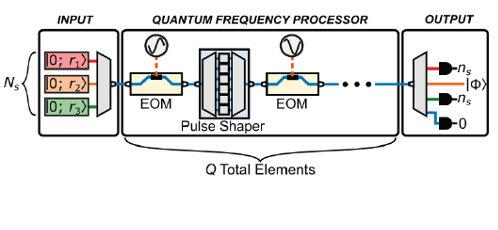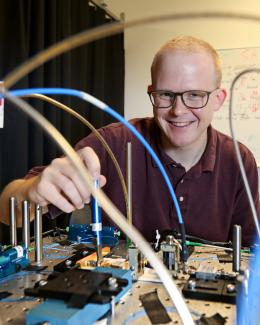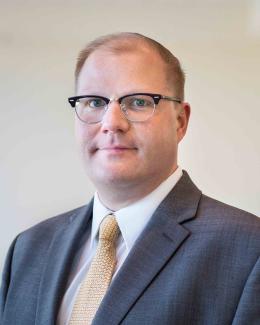
The Science
A team led by ORNL scientists in collaboration with University of Arizona researchers developed a new approach to engineer non-Gaussian photonic states in discrete frequency bins. This approach combines quantum frequency processing (QFP) with photon number-resolving detection. Simulated examples demonstrate the potential to produce high-fidelity Schrödinger cat states with a reasonable amount of existing resources.
The Impact
- Non-Gaussian quantum states of light are critical resources for optical quantum repeaters, but efficient methods to generate these states so far remain elusive.
- This study lays out a mathematical framework to produce complex quantum states in frequency bins for the first time.
- Results pave the way for single-spatial-mode, fiber-optic-compatible non-Gaussian quantum states.
- Next steps include factoring in loss, designing GKP qubits, and experimental demonstration.
PI/Facility Lead: Joseph M. Lukens and Nicholas A. Peters
Funding: DOE Transparent Optical Quantum Networks for Distributed Science Program, Early Career Research Program, ASCR
Publication for this work:
- Pizzimenti, A., Lukens, J,,Lu, H., Peters, N., Guha, S. & Gagatsos, C. “Non-Gaussian Photonic State Engineering with the Quantum Frequency Processor.” Physical Review A 104, 2021. https://journals.aps.org/pra/abstract/10.1103/PhysRevA.104.062437
Team Members: Andrew J. Pizzimenti (ORNL), Joseph M. Lukens (ORNL), Hsuan-Hao Lu (Purdue University), Nicholas A. Peters (ORNL), Saikat Guha (University of Arizona), Christos Gagatsos (University of Arizona)
Summary: This work develops an approach for engineering non-Gaussian photonic states in discrete frequency bins. Combining the quantum frequency processor and photon number-resolving detection, simulated examples demonstrate the potential for producing high-fidelity cat states with reasonable resource requirements.
Acknowledgement of support: This work was funded in part by the DOE Office of Science, Advanced Scientific Computing Research (ASCR) program.




